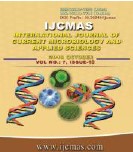


 National Academy of Agricultural Sciences (NAAS)
National Academy of Agricultural Sciences (NAAS)

|
PRINT ISSN : 2319-7692
Online ISSN : 2319-7706 Issues : 12 per year Publisher : Excellent Publishers Email : editorijcmas@gmail.com / submit@ijcmas.com Editor-in-chief: Dr.M.Prakash Index Copernicus ICV 2018: 95.39 NAAS RATING 2020: 5.38 |
Staphylococcus aureus causes skin and soft tissue infections (SSTIs), if not treated with proper antimicrobials can leads to serious form of infection. Multi-drug resistant strains left us very few therapeutic alternatives, in such cases clindamycin can be a good option with true sensitivity. The clinical samples exhibiting skin and soft tissue infection received in the department of microbiology further subjected to isolation of Staphylococcus aureus. Isolated strains further subjected to D-test to detect inducible clindamycin resistant strains as per standard guidelines. Antimicrobial susceptibility testing performed for all the isolates as per CLSI guidelines. A total of 176 Staphylococcus aureus, 82 were isolated from skin and soft tissue infection. Out of 82 strains, 23(28%) were inducible clindamycin resistant strains of Staphylococcus aureus, 49(59.8%) were constitutive resistant, and 10(12.2%) were MS phenotype. All the isolates were sensitive to vancomycin, followed by doxycyclin 62(75.6%), Amikacin 60(73.2%) and 57(69.5%) were sensitive to linezolid. Detection of inducible clindamycin resistant strains of Staphylococcus aureus on routine basis is crucial for judicial use of the drug and proper institution of the therapy especially in skin and soft tissue infections.
 |
 |
 |
 |
 |